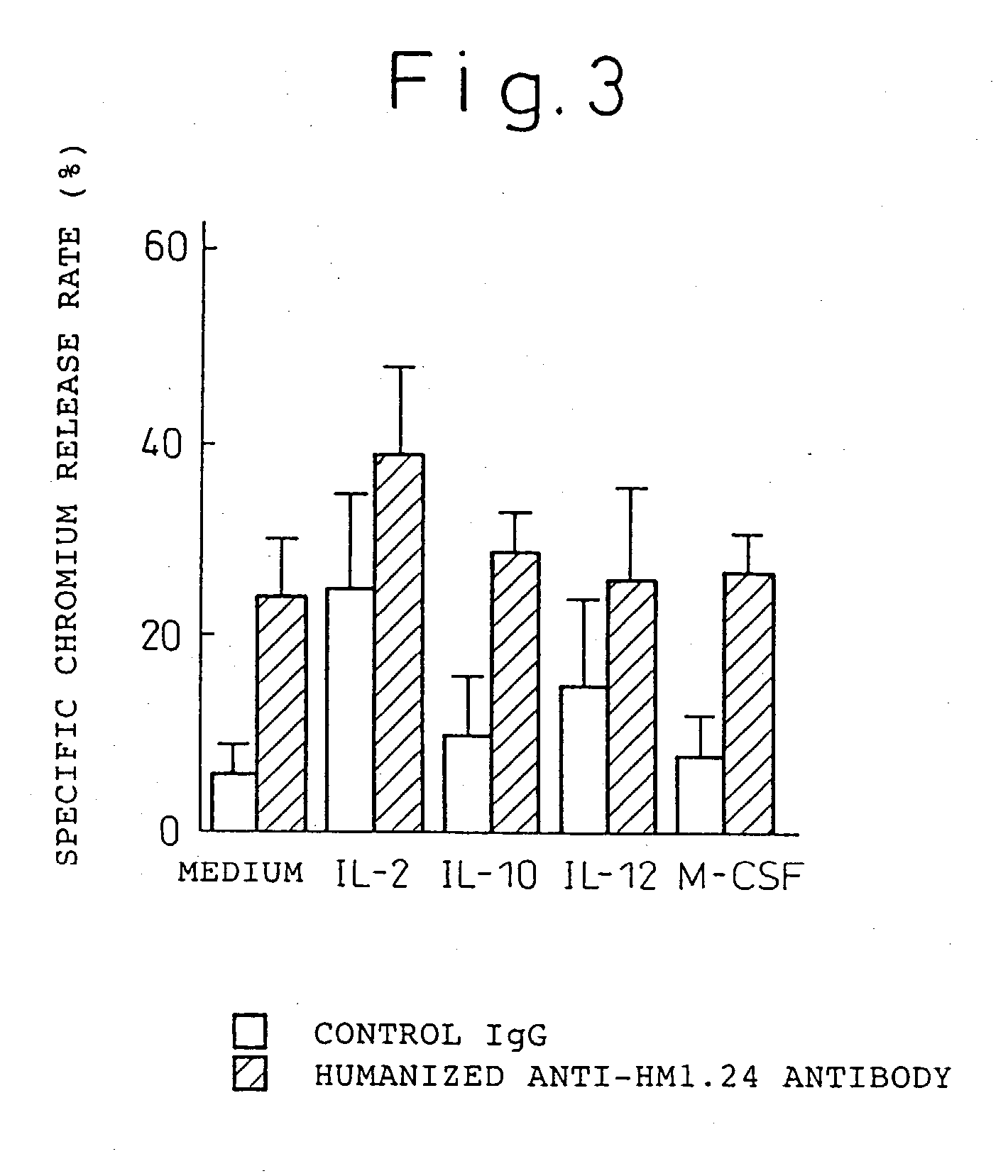Enhancer for antibody to lymphocytic tumors
a lymphocytic tumor and antibody technology, applied in the field of enrichment of antibody to lymphocytic tumors, can solve the problems of perfectness and achieve the effect of reviving a normal level of cytotoxic activity and more potent cytotoxic activity
- Summary
- Abstract
- Description
- Claims
- Application Information
AI Technical Summary
Benefits of technology
Problems solved by technology
Method used
Image
Examples
examples
[0119] The present invention will now be explained hereinbelow in more detail with reference to the following examples. It is to be noted, however, that the present invention is not limited to these examples in any way.
reference example 1
Preparation of Hybridomas that Produce Mouse Anti-HM1.24 Monoclonal Antibody
[0134] In accordance with the method of Goto, T. et al., Blood (1994) 84, 1992-1930, hybridomas that produce mouse anti-HM1.24 monoclonal antibody were prepared.
[0135] A plasma cell line KPC-32 (1.times.10.sup.7 cells) derived from the bone marrow of a patient with human multiple myeloma (Goto, T. et al., Jpn. J. Clin. Hematol. (1991) 32, 1400) was injected twice to the abdominal cavity of a BALB / c mouse (manufactured by Charles River) every six weeks.
[0136] Three days prior to sacrificing the animal, 1.5.times.10.sup.6 KPC-32 was injected to the spleen of the mouse in order to further enhance the antibody-producing ability of the mouse (Goto, T. et al., Tokushima J. Exp. Med. (1990) 37, 89). After sacrificing the animal the spleen was extracted and the extracted organ was subjected to cell fusion with the myeloma cell SP2 / 0 according to the method of Groth, de St. & Schreidegger (Cancer Research (1981) 41, ...
reference example 2
Preparation of Humanized anti-HM1.24 Antibody
[0142] Humanized anti-HM1.24 antibody was obtained according to the method described in International Patent Application WO 98-14580.
[0143] From the hybridoma HM1.24 prepared in Reference example 1, total RNA was prepared by the conventional method. From this, cDNA encoding the V region of mouse antibody was synthesized and amplified by a polymerase chain reaction (PCR) method and the 5'-RACE method. A DNA fragment containing the gene encoding the mouse V region was obtained and was ligated to each plasmid puC cloning vector and then introduced into competent E. coli cells to obtain an E. coli transformant. The above plasmid was obtained from the transformant. The base sequence of the cDNA coding region in the plasmid was determined in the conventional method, and the complementarity determining region (CDR) of each V region was determined.
[0144] In order to construct a vector expressing chimeric anti-HM1.24 antibody, cDNA encoding the V ...
PUM
| Property | Measurement | Unit |
|---|---|---|
| pH | aaaaa | aaaaa |
| incubation time | aaaaa | aaaaa |
| concentration | aaaaa | aaaaa |
Abstract
Description
Claims
Application Information
 Login to View More
Login to View More - R&D
- Intellectual Property
- Life Sciences
- Materials
- Tech Scout
- Unparalleled Data Quality
- Higher Quality Content
- 60% Fewer Hallucinations
Browse by: Latest US Patents, China's latest patents, Technical Efficacy Thesaurus, Application Domain, Technology Topic, Popular Technical Reports.
© 2025 PatSnap. All rights reserved.Legal|Privacy policy|Modern Slavery Act Transparency Statement|Sitemap|About US| Contact US: help@patsnap.com



